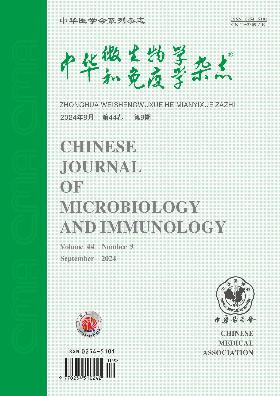Protective effects of leflunomide on salivary function of submandibular gland in NOD mice
Q4 Immunology and Microbiology
引用次数: 0
Abstract
Objective To investigate the therapeutic effects of leflunomide on salivary gland secretion hypofunction in NOD mice with Sjogren′s syndrome. Methods NOD mice were randomly divided into four groups: prevention group, prevention control group, treatment group and treatment control group. Salivary flow rate was measured after pilocarpine stimulation. Changes in the average number and area of infiltrating lesions were compared after hematoxylin and eosin (HE) staining. The percentages of CD3+ T, CD4+ T, CD8+ T, CD44+ CD62L-CD4+ T, CD19+ B and CD138+ B cells in submandibular gland and spleen were detected by flow cytometry. The levels of TNF-α, IL-17A and IL-6 in serum were detected by CBA method. Results The salivary flow rate (t=-5.81, P<0.001; t=-3.61, P<0.05), the number of infiltrating lesions(t=3.95, P<0.01; t=4.94, P<0.001)and the average area of infiltrating lesions(t=3.18, P<0.05; t=2.35, P<0.05)were significantly ameliorated in the prevention and treatment groups. Moreover, CD3+ CD4+ T cells(t=2.39, P<0.05; t=3.82, P<0.01)and CD44+ CD62L-CD4+ T cells(t=3.53, P<0.05; t=3.36, P<0.05)in the submandibular gland were significantly decreased. CD3+ T(t=6.08, P<0.001; t=2.76, P<0.05), CD3+ CD4+ T (t=3.73, P<0.05; t=2.39, P<0.05), CD19+ B (t=5.88, P<0.001; t=4.23, P<0.01) and CD138+ B cells (t=4.30, P<0.001; t=4.46, P<0.01) in the spleen were also significantly reduced. Serum IL-17A (t=4.15, P<0.01; t=3.36, P<0.01) in the two groups and TNF-α (t=4.56, P<0.001) in the prevention group were down-regulated, but no significant difference was observed in IL-6 level. Conclusions This study suggested that leflunomide could prevent and improve salivary gland hypofunction and inhibit immune activation in NOD mice, providing reference for evaluating leflunomide in the treatment of Sjogren′s syndrome. Key words: Sjogren′s syndrome; Leflunomide; NOD mice; Salivary gland function; Lymphocyte; Inflammatory cytokine来氟米特对NOD小鼠下颌下腺唾液功能的保护作用
目的探讨来氟米特对干燥综合征NOD小鼠涎腺分泌功能减退的治疗作用。方法将NOD小鼠随机分为预防组、预防对照组、治疗组和治疗对照组。匹罗卡品刺激后测定唾液流速。苏木精和伊红(HE)染色后比较浸润病灶平均数目和面积的变化。采用流式细胞术检测颌下腺和脾脏中CD3+ T、CD4+ T、CD8+ T、CD44+ CD62L-CD4+ T、CD19+ B和CD138+ B细胞的百分比。采用CBA法检测血清中TNF-α、IL-17A、IL-6水平。结果唾液流率(t=-5.81, P<0.001;t=-3.61, P<0.05),浸润病灶数(t=3.95, P<0.01;t=4.94, P<0.001),平均浸润病灶面积(t=3.18, P<0.05;t=2.35, P<0.05)均显著改善。CD3+ CD4+ T细胞(T =2.39, P<0.05;t=3.82, P<0.01)和CD44+ CD62L-CD4+ t细胞(t=3.53, P<0.05;t=3.36, P<0.05)。CD3+ T(T =6.08, P<0.001);t=2.76, P<0.05), CD3+ CD4+ t (t=3.73, P<0.05;t=2.39, P<0.05), CD19+ B (t=5.88, P<0.001;t=4.23, P<0.01)和CD138+ B细胞(t=4.30, P<0.001;t=4.46, P<0.01)。血清IL-17A (t=4.15, P<0.01;t=3.36, P<0.01),预防组TNF-α水平下调(t=4.56, P<0.001),但IL-6水平差异无统计学意义。结论来氟米特可预防和改善NOD小鼠唾液腺功能减退,抑制免疫激活,为评价来氟米特治疗干燥综合征提供参考。关键词:干燥综合征;Leflunomide;点头老鼠;唾液腺功能;淋巴细胞;炎性细胞因子
本文章由计算机程序翻译,如有差异,请以英文原文为准。
求助全文
约1分钟内获得全文
求助全文
来源期刊

中华微生物学和免疫学杂志
Immunology and Microbiology-Virology
CiteScore
0.50
自引率
0.00%
发文量
6906
期刊介绍:
Chinese Journal of Microbiology and Immunology established in 1981. It is one of the series of journal sponsored by Chinese Medical Association. The aim of this journal is to spread and exchange the scientific achievements and practical experience in order to promote the development of medical microbiology and immunology. Its main contents comprise academic thesis, brief reports, reviews, summaries, news of meetings, book reviews and trends of home and abroad in this field. The distinguishing feature of the journal is to give the priority to the reports on the research of basic theory, and take account of the reports on clinical and practical skills.
 求助内容:
求助内容: 应助结果提醒方式:
应助结果提醒方式:


